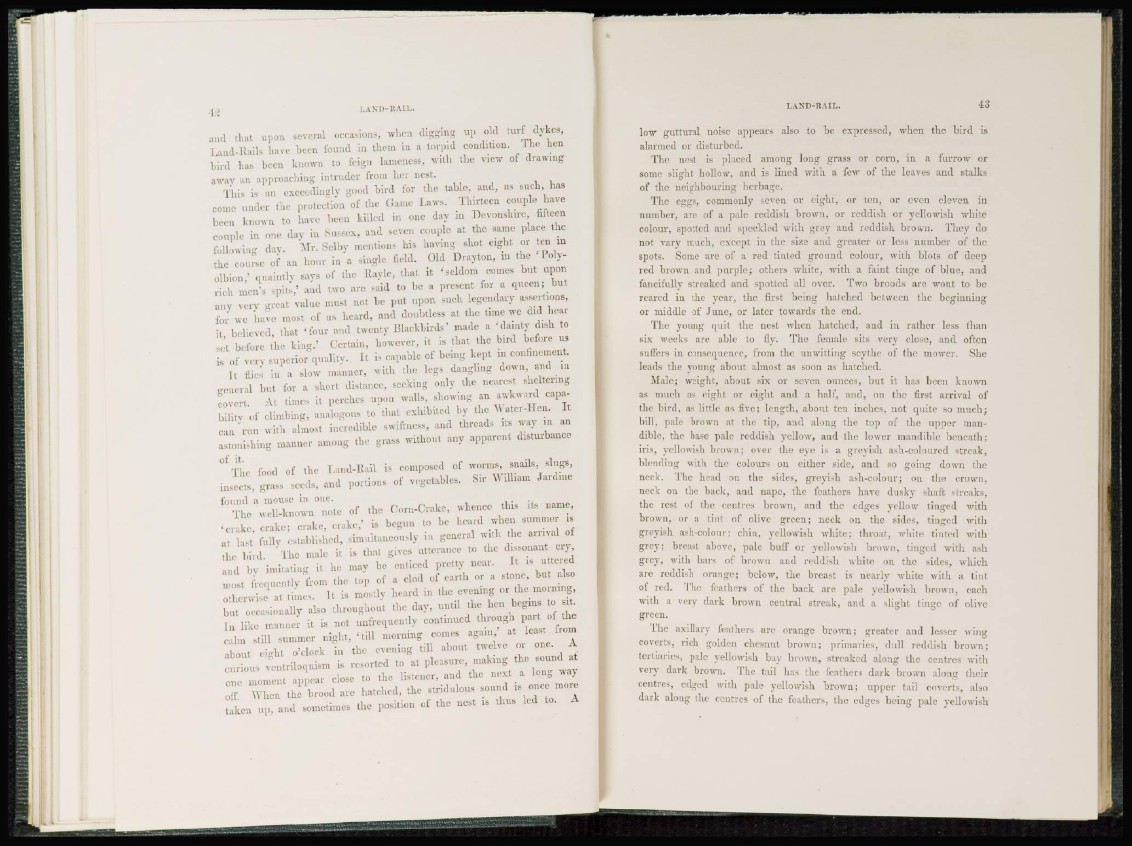
42 LAND-RAIL.
and that upon several occasions, when digging up old turf dykes,
hand-Hails have been found in them in a torpid condition. The hen
b i r d has been known to feign lameness, with the view of drawing
away an approaching intruder from her nest.
This is an exceedingly good bird for the table, and, as such, has
come under the protection of the (lame Laws. Thirteen couple have
been known to have been killed in one day in Devonshire, fifteen
couple in one day in Sussex, and seven couple at the same place the
following day. Mr. Sclby mentions his having shot eight or teu in
t h e course of an hour in a single field. Old Drayton, in the ' Polyolbion,'
quaintly says of the Itayle, that it 'seldom comes but upon
rich men's spits,' aud two are said to be a present for a queen; but
any very great value must not be put upon such legendary assertions,
for we have most of us heard, and doubtless at the time we did hear
il, believed, that 'four and twenty Blackbirds' made a ' d a i n t y dish to
set before the king.* Certain, however, it is that the bird before us
is of very superior quality. It is capable of being kept in confinement.
I t files in a slow manner, with the legs dangling down, and in
general but for a short distance, seeking only the nearest sheltering
covert. At times it perches upon walls, showing an awkward capability
of climbing, analogous to that exhibited by the Water-Hen. It
can run with almost incredible swiftness, and threads its way in an
astoni-hing manner among the grass without any apparent disturbance
of it.
The food of the Land-Bail is composed of worms, snails, slugs,
insects, grass seeds, and portions of vegetables. Sir AVilliam Jar dine
found a mouse in one.
The well-known note of the Corn-Crake, whence this its name,
' c r a k e , crake; crake, crake,' is begun to be heard when summer is
at last fully established, simultaneously in general with the arrival of
the bird. The male it is that gives utterance to the dissonant cry,
and by imitating it he may be enticed pretty near. It is uttered
most frequently from the top of a clod of earth or a stone, but also
otherwise at times. It is mostly heard in the evening or the morning,
but occasionally also throughout the day, until the hen begins to sit.
I n like manner it is not (infrequently continued through part of the
calm still summer night, 'till morning comes again,' at least from
about eight o'clock in the evening till about twelve or one. A
curious ventriloquism is resorted to at pleasure, making the sound at
one moment appear close to the listener, and the next a long way
oil'. When the brood are hatched, the stridulous sound is once more
taken up, and sometimes the position of the nest is thus led to. A
LAND-RAIL. 43
low guttural noise appears also to be expressed, when the bird is
alarmed or disturbed.
The nest is placed among long grass or corn, in a furrow or
some slight hollow, and is lined with a few of the leaves and stalks
of the neighbouring herbage.
The eggs, commonly seven or eight, or ten, or even eleven in
number, are of a pale reddish brown, or reddish or yellowish white
colour, spotted and speckled with grey and reddish brown. They do
not vary much, except in the size and greater or less number of the
spots. Some are of a red tinted ground colour, with blots of deep
red brown and purple; others white, with a faint tinge of blue, and
fancifully streaked and spotted all over. Two broods are wont to be
reared in the year, the first being hatched between the beginning
or middle of June, or later towards the end.
The young quit the nest when hatched, and in rather less than
six weeks are able to fly. The female sits very close, and often
sailers in consequence, from the unwitting scythe of the mower. She
leads the young about almost as soon as hatched.
Male; weight, about six or seven ounces, but it has been known
as much as eight or eight and a half, and, on the first arrival of
the bird, as little as five; length, about ten inches, not quite so much;
bill, pale brown at the tip, and along the top of the upper mandible,
the base pale reddish yellow, and the lower mandible beneath;
iris, yellowish brown; over the eye is a greyish ash-coloured streak,
blending with the colours on cither side, and so going down the
neck. The head on the sides, greyish ash-colour; on tin; crown,
neck on the back, and nape, the feathers have dusky shaft streaks,
the rest of the centres brown, and the edges yellow tinged with
brown, or a tint of olive green; neck on the sides, tinged with
greyish ash-colour: chin, yellowish white; throat, white tinted with
grey; breast above, pale buff or yellowish brown, tinged with ash
grey, with bars of brown and reddish white on the sides, which
are reddish orange; below, the breast is nearly white with a tint
of red. The feathers of the back are pale yellowish brown, each
with a very dark brown central streak, and a slight tinge of olive
green.
I he axillary feathers arc orange brown; greater and lesser wing
coverts, rich golden chesnut brown; primaries, dull reddish brown;
tertiaries, pale yellowish bay brown, streaked along the centres with
very dark brown. The tail has the feathers dark brown along their
centres, edged with pale yellowish brown; upper tail coverts, also
dark along the centres of the feathers, the edges being pale yellowish